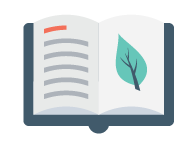When we describe different objects or places in our daily life, we usually point out how distant they are; near or far. And there is a way to say that in English.
How can you point out objects and say if they are near or far?
How can you indicate that a friend is coming?
In this section, you will learn how to express this. Continue doing the exercises, and you will discover how to do it.
You will find all the grammatical rules for using demonstrative adjectives.
You will read some texts and complete them with demonstrative adjectives.
You will listen to some descriptions, and answer some sentences.
You will write a text using a model.
You will record some dialogues.
By the end of this topic you will:
Use the demonstrative adjectives to show proximity or distance to people, places and things.
We use demonstrative adjectives when we want to show the distance between the speaker and the object.

This is a book. |

These are books. |

That is a book. |

Those are books. |
This indicates something is close to the speaker. We use it with singular nouns.
Examples:
This is my brother.
This isn´t my car.
Is this your pen?
That indicates something is far from the speaker. We use it with singular nouns.
Examples:
That is my uncle.
That isn’t our car.
Is that their cat?
These indicates some things are close to the speaker. We use it with plural nouns.
Examples:
These are my pupils.
These aren´t his papers.
Are these your books?
Those indicates some things are far to the speaker. We use it with plural nouns.
Examples:
Those are my socks.
Those aren’t my maps.
Are those your pencils?
Notice there are four words to express our proximity to people or things. However, if you have any difficulty in identifying when to use this, that, these or those. Watch the following video that will give you more examples.
Let’s see if you have understood how to use demonstrative adjectives by doing the following activity.
Look at the pictures and decide which demonstrative adjective (this, that, these or those) you need to use.
Activity 1
When we are describing the distance between a person or a thing we use demonstrative adjectives.
In this activity, you must complete the sentences with the missing information. Read and then complete the sentences.
Drag the different options to the appropriate spaces to complete the sentences. You have two attempts to answer them. You can check your score at the end of the activity.
Activity 2
When we don’t know who owns something, we use demonstrative adjectives to identify their owner. Listen to the following dialogues.
Listening 1
Listening 2
Match the questions from the left column to the appropriate answer in the right column. You have two attempts to answer. You can check your score at the end of the activity.
Activity 3
Some friends are talking about important objects that belong to them. Listen to the following sentences and click on the word you hear.
Match the questions from the left column to the appropriate answer in the right column. You have two attempts to answer. You can check your score at the end of the activity.
Activity 4
Now it is your turn to describe something. You can describe your:
If you choose your family, answer the following questions to help you to write a short paragraph.
If you choose your favourite place, answer the following questions to help you write a short paragraph.
Use the paragraphs on the Reading Section as a model.
Write a short paragraph with your description.
You will find a rubric to evaluate yourself.
Look at the following example:
Activity 5
Prepare your sentences in a word document. Then record it on the free application vocaroo.com. Once you finish the recording, listen to it again.
You will find a checklist to evaluate your grammar, vocabulary, pronunciation and fluency performance.
Recording a description.
In this activity, you have to complete the dialogues with the phrases given. And then you have to record yourself to practice your speaking.
Dialogue 1.
A: Hi. Bob.
B: Hello. Max.
A: 1 __________________
B: Oh! It is my new cell phone
A: Wow! It’s the newest in the market!
B: And, 2 _____________________
A: They are my new headphones.
B: They are so nice!
A: And whose tablet is this? Is it yours?
B: No, 3 ___________________
Dialogue 2.
A: Hello, Anne!
B: Oh! Jenny hi!
A: 1 ___________________________
B: No, they are Monica’s.
A: 2 __________________________
B: She is my sister.
A: Oh! They are so nice.
B: 3 ___________________. They are nice.
Phrases to complete:
a) I don’t know.
b) What are those?
c) You’re right!
d) What is this?
e) Are those your new sunglasses?
f) Who’s Monica?
Then, check your audio with the following checklist.
Easy? Now you can develop your own dialogue describing an object!
Self-assessment 1
In this quiz, you will look at some sentences, and choose the correct answer.
Self-Assessment 2